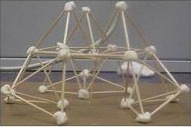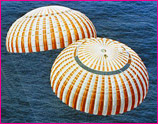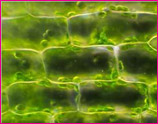Posted on October 27th, 2008 by ASEE
 Using spaghetti and marshmallows, students in grades 5 – 7 experiment with different structures to determine which ones can handle the greatest amount of load. Their experiments help them understand compression and tension forces in relation to the strength of structures.
Using spaghetti and marshmallows, students in grades 5 – 7 experiment with different structures to determine which ones can handle the greatest amount of load. Their experiments help them understand compression and tension forces in relation to the strength of structures.
Read More
Filed under: Class Activities, Grades 6-8 | 10 Comments »
Tags: Building Design, Civil Engineering, Team-building skills
Posted on August 18th, 2008 by ASEE
Students write a biographical sketch of an artist or athlete who lives on the edge, riding the gravity wave, to better understand how these artists and athletes work with gravity and manage risk.
Read More
Filed under: Class Activities, Grades 6-8 | Comments Off on Report Writing: Athletes and Gravity
Tags: Atheletes, Gravity, Lesson Plan
Posted on June 26th, 2008 by ASEE
 Students create a parachute using different materials they think will work best. They test their designs then join a class discussion and possible journal writing to evaluate which paper material worked best.
Students create a parachute using different materials they think will work best. They test their designs then join a class discussion and possible journal writing to evaluate which paper material worked best.
Read More
Filed under: Grades 6-8, Lesson Plans | Comments Off on Lesson: Design a Parachute
Tags: Aerodynamics, Aerospace Engineering
Posted on June 18th, 2008 by ASEE
Students read news reports and first-person accounts to imagine what it would be like to be in a blackout in a large city. They follow news reports as if in real-time, keep weblogs or journals, take on different roles, then use their journal accounts to create a play or screenplay.
Read More
Filed under: Grades 6-8, Lesson Plans | Comments Off on Blackout!
Posted on May 1st, 2008 by ASEE
In this activity, students will gain a basic understanding of an electrical circuit – the basis of electrical engineering. Students build a wire circuit and pass a paperclip through a maze, trying not to touch the wire.
Read More
Filed under: Grades 6-8, Lesson Plans | Comments Off on Wire Maze
Posted on March 19th, 2008 by ASEE
Students learn how environmental engineers monitor water quality in resource use and design. They employ environmental indicators to assess the water quality of a nearby stream, and make general observations of water quality, as well as count the number of macroinvertabrates. They use the information collected to create a scale to rate the stream’s water quality. Finally, class members compare their numbers and discuss and defend their results.
Read More
Filed under: Grades 6-8, Lesson Plans | Comments Off on Stream Consciousness
Posted on February 3rd, 2008 by ASEE
 Students learn a simple technique for quantifying the amount of photosynthesis that occurs in a given period of time, using a common water plant (Elodea). They can use this technique to compare the amounts of photosynthesis that occur under conditions of low and high light levels. Before the experiment, students come up with a well-worded hypothesis to be tested. After the experiment, students pool their data to get a large sample size, determine the measures of central tendency of the class data, then graph and interpret the results.
Students learn a simple technique for quantifying the amount of photosynthesis that occurs in a given period of time, using a common water plant (Elodea). They can use this technique to compare the amounts of photosynthesis that occur under conditions of low and high light levels. Before the experiment, students come up with a well-worded hypothesis to be tested. After the experiment, students pool their data to get a large sample size, determine the measures of central tendency of the class data, then graph and interpret the results.
Read More
Filed under: Grades 6-8, Grades K-5, Lesson Plans | Comments Off on Bubbling Plants
Posted on January 16th, 2008 by ASEE
This activity introduces students to the concept of the engineering design process and how to apply it. They first receive background instruction about biomedical engineering or bioengineering. Then they learn about material selection and material properties through a guide created for them. Students then break into small groups and brainstorm. Each group is assigned a specific design problem, is given materials, and is asked to create a prototype. To finish, they communicate their solution through a poster presentation.
Read More
Filed under: Grades 6-8, Lesson Plans | Comments Off on Broken Bones
Posted on December 18th, 2007 by ASEE
Students conduct several simple lab activities to learn about the five fundamental load types that can act on structures: tension, compression, shear, bending, and torsion. In this activity, students will play the role of molecules in a beam subject to various loading schemes.
Read More
Filed under: Grades 6-8, Lesson Plans | Comments Off on Forces on the Human Molecule
 Using spaghetti and marshmallows, students in grades 5 – 7 experiment with different structures to determine which ones can handle the greatest amount of load. Their experiments help them understand compression and tension forces in relation to the strength of structures.
Using spaghetti and marshmallows, students in grades 5 – 7 experiment with different structures to determine which ones can handle the greatest amount of load. Their experiments help them understand compression and tension forces in relation to the strength of structures. 








 Students create a parachute using different materials they think will work best. They test their designs then join a class discussion and possible journal writing to evaluate which paper material worked best.
Students create a parachute using different materials they think will work best. They test their designs then join a class discussion and possible journal writing to evaluate which paper material worked best. Students learn a simple technique for quantifying the amount of photosynthesis that occurs in a given period of time, using a common water plant (Elodea). They can use this technique to compare the amounts of photosynthesis that occur under conditions of low and high light levels. Before the experiment, students come up with a well-worded hypothesis to be tested. After the experiment, students pool their data to get a large sample size, determine the measures of central tendency of the class data, then graph and interpret the results.
Students learn a simple technique for quantifying the amount of photosynthesis that occurs in a given period of time, using a common water plant (Elodea). They can use this technique to compare the amounts of photosynthesis that occur under conditions of low and high light levels. Before the experiment, students come up with a well-worded hypothesis to be tested. After the experiment, students pool their data to get a large sample size, determine the measures of central tendency of the class data, then graph and interpret the results.